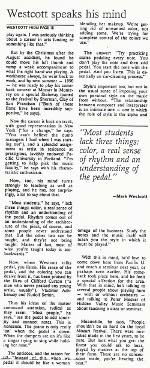Westcott Speaks His Mind

. . . "I was seriously thinking about a career in arts funding or something like that."
But by the Christmas after the August accident, he found he could move his left thumb and vamp a weak accompaniment to what the right hand was playing. A workhorse always, he went back to work, and by the next summer—1990—he was ready to play his comeback concert at Mozart in Monterey on a special Steinway loaned to the festival by Sherman, Clay of San Francisco ("Both of these firms have been incredibly supportive," he says).
Now the career is back on track, with good representation in New York ("For a change," he says. "You can't believe the dumb managers I had when I was starting out"), and a splendid assignment as artist in residence at prestigious, lavishly endowed Pacific University in Portland. "I'm getting to help pick the music faculty," he says with his characteristic enthusiasm.
Now, too, his mind turns strongly to teaching as well as playing, and he has, not surprisingly, a lot to say about that.
"Most students," he says, "lack three things: color, a real sense of rhythm and an understanding of the pedal. Rhythm comes out of an understanding of the architecture of the piece, of course, and some people never understand that. But the other two can be taught, and they're not being taught. Matter of fact, most of what you're taught today is ass-backwards."
Now when Westcott talks pedal, you listen. His sense of the pedal, and the coloring you can derive from it, has been praised by the likes of Clifford Curzon ("a man who never praised any young artist, usually"), Vladimir Ashkenazy and Rudolf Serkin.
Thus his ideas on the matter command attention, radical as they seem. "Most people," he says, "use the pedal to add sonority and connect notes. This is nonsense. The piano is only really 'on' when the pedal is down. When the dampers are on it's like a singer trying to sing while holding her nose."
The antidote and the reason for it? "Instead of this . . . when we pedal it should be like a woman blending her makeup. We're getting rid of unwanted color, not adding some. We're trying for complete control for the colors we use."
The answer: "Try practicing scales pedaling every note. You don't play the note and then add the pedal. You start the note with the pedal. And you listen. This is essentially and ear-cleaning process."
Style's important too, but not in the usual sense of imposing your own personal style on the music from without. "The relationship between composer and interpreter is an intimate one—one in which the role of style is the alpha and the omega of the business. Study the notes and the music itself will teach you the style in which it must be played."
With this in mind, he'd love to come down here from Pacific U. and teach a seminar next year, or perhaps even earlier. His comeback took place here, and he feels a special affection for the area. With that in mind, he's talking to several people about playing here—with or without orchestra—and talking to Peter Meckel of Hidden Valley Music Seminars about teaching a class or a seminar.
Meanwhile, he says, "People shouldn't be so hard on the local Mozart festival. There were mistakes made in the first years to be sure. But look what you get: the finest you could ask to hear, played by masters at the top of their form. There are no concessions made; you're hearing the best."
Copied by Ben Serna-Grey
comments powered by Disqus